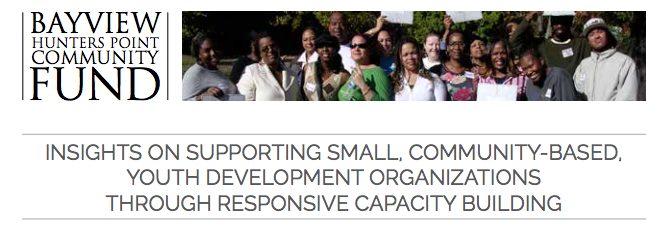
Placing Your Trust in Trust: A Lesson from the Field
This is homage to the work of a foundation that made a commitment to doing things differently: Bayview Hunters Point Community Fund. Many foundations have launched grant making and capacity building initiatives but when it was the Bayview Hunters Point Community Fund’s turn, they decided to lead with recognition of the importance of trust, which would guide and ground their work.
The Fund knew something about the community they came to, which others have forgotten: Bayview Hunters Point like many low-income African American communities had a history of people coming into the community to fix them and staying with the work not long enough to see any meaningful result. (Yes, sometimes we as funders have our own form of ADHD.) Knowing that trust was an issue, they moved with intentionality to build the kind of trust that leads to honest dialogue and authentic relationships that are the foundation of successful grantmaking initiatives.
I recall being a young nonprofit professional trying to reach out to people in the Bay view Hunters Point community. I found it challenging to be the “outsider” but couldn’t figure out what I could do to make it better and so I did what came naturally: I talked to the people who would talk to me so they could determine for themselves whether or not I was the “real thing.” It was a slow process that required a lot of patience for a 20 year old. Given my own experience in BVHP, I was struck by the Bayview Fund’s patient investment in the community and commitment to working in ways that are aligned with what we at The Whitman Institute call trust based investment.
From 2001- 2014 the Bayview Fund worked in “true” partnership with youth-serving organizations in Bayview Hunters Point. Last month the Bayview Fund issued a report, sharing its lessons learned from 13 years of being in true partnership with youth-serving organizations of Bayview Hunters Point. Providing what the Fund calls “responsive capacity building,” their big lesson was “effective capacity building for small organizations working in under-resourced communities like Bayview Hunters Point requires a long-term commitment, flexible funding, and a willingness of both grantee and grantor to be vulnerable and open to change and input.” At the heart of their approach is the cultivation and maintenance of a trusting and open grantor-grantee relationship.
When I read the report, the commitment to doing things differently ended up being an example of trust based investment where a funder is truly in service to its grantees, listens and responds to them, puts relationships first, and invests for the long term. The story of the Bayview Fund provides valuable insights into what it takes to achieve an “open and mutual partnership,” which is a key premise of TWI’s practice of trust based giving. As we move into a new year, my hope is that the story of the Bayview Fund inspires other funders and investors to build the kind of true partnerships that are essential to a trust based practice of philanthropy and, above all, crucial to achieving one’s philanthropic goals.
Here’s to unleashing more philanthropy in 2015 that is like the work of the Bayview Fund: kind and compassion; smart and sophisticated; committed and intentional; trusting and impactful.